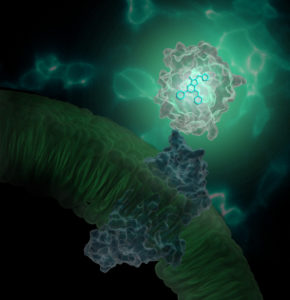
Getting DNA or RNA into cells can be a tricky business, and a variety of transfection reagents have been developed over the years to make the process easier. Lipid-based reagents are especially popular because they combine efficient transfection with relatively low toxicity.
When it comes to transfection, it pays to think small. Human cells range in volume from 20–40 µm3 (sperm cells) to as large as 4 million µm3 (mature egg cells, or oocytes). For several decades, transfection reagents have targeted this size range. However, breakthrough research involves leaving the “micro” realm and entering a world that was once the domain only of science fiction: nanotechnology.
What is nanotechnology? The generally accepted definition is any form of science, engineering or technology that involves components on a scale between 1–100 nm (1 nm = 0.001 µm). Although many of the milestones in nanotechnology encompass developments in materials science and engineering, life science research has also benefited from this science of the very small. It’s no surprise that, early on, a promising use for nanotechnology involved therapeutic delivery of small molecules into living cells to correct genetic anomalies or stop the progression of disease.
Although we haven’t yet reached the stage where nanometer-sized robots can repair damaged DNA within cells, considerable attention has been devoted to the development of lipid nanoparticles (LNPs) for transfection. These LNPs are formed in solution from reagents similar to those used for standard transfection, and they’ve been used successfully for intravenous administration of drugs, including small interfering RNA (siRNA) molecules (reviewed in Cullis and Hope, 2017). Two studies published this year have explored the use of LNPs in applied research.
Oral Administration of LNPs
The first study by Ball et al. examined the fate of LNPs when administered orally—a subject about which little was known previously, despite the significant therapeutic potential for treating diseases of the gastrointestinal (GI) tract. Previously, the group had used LNPs to deliver siRNA molecules to intestinal epithelial cells in culture. In this study, they developed an in vitro system that mimicked conditions found in the stomach and intestine. The LNPs were produced by dissolving a mixture of lipids, cholesterol, a phosphatidylcholine derivative and polyethylene glycol in a solution containing 90% ethanol and 10% sodium citrate buffer. This mixture was added to siRNA, and LNPs were formed upon vortexing the solution.
The LNPs remained stable following exposure to simulated gastric acid conditions with pH as low as 1.2. Following this incubation, the LNPs were used successfully to transfect HeLa cells as assessed by luciferase expression using a Dual-Glo™ Luciferase Assay System. Further experiments in mice showed that the LNPs containing siRNAs were retained in the GI tract for at least 8 hours. The results of these experiments suggest that oral delivery of LNPs is a viable route for siRNA treatment of intestinal epithelial cells.
CRISPR-Cas9 Gene Editing
The second study by Dombrowski et al. used LNPs as a delivery vehicle for a CRISPR-Cas9 system intended to target the transthyretin (Ttr) gene in mouse liver. The current methods of delivering CRISPR-Cas9 in vivo primarily use viral vectors. Viral delivery raises a number of safety concerns, due to the ability to trigger an adaptive immune response and sustained vector expression levels following integration into the host genome. In contrast, LNPs should offer transient expression of Cas9 because they are broken down in the liver. For these experiments, LNPs were prepared using an ethanolic solution with microfluidic mixing instead of vortexing. Both in vitro experiments using mouse hepatocytes and in vivo experiments in mice demonstrated successful delivery of the CRISPR-Cas9-LNP complex. A single administration resulted in significant editing of the target Ttr gene, with a 97% reduction in serum TTR protein levels that persisted over at least 12 months after transfection. This study positions LNPs as a durable, biodegradable route for delivery of CRISPR-Cas9 systems to effect therapeutically meaningful levels of gene editing.
As noted by Cullis and Hope, LNPs contain a variety of modifiable components that can be customized for specific therapeutic applications. This design flexibility, low toxicity and broad range of applications for LNPs could make them an important tool in developing highly targeted approaches to therapy in the near future.
References
Ball, R.L., Bajaj, P. and Whitehead, K.A. (2018) Oral delivery of siRNA lipid nanoparticles: Fate in the GI tract. Sci. Rep. 8, 2178. doi:10.1038/s41598-018-20632-6
Cullis, P.R. and Hope, M.J. (2017) Lipid nanoparticle systems for enabling gene therapies. Mol. Ther. 25, 1467. doi:10.1016/j.ymthe.2017.03.013
Finn, J.D. et al. (2018) A single administration of CRISPR/Cas9 lipid nanoparticles achieves robust and persistent in vivo genome editing. Cell Rep. 22, 2227. doi:10.1016/j.celrep.2018.02.014
Latest posts by Ken Doyle (see all)
- Will Artificial Intelligence (AI) Transform the Future of Life Science Research? - February 1, 2024
- RAF Inhibitors: Quantifying Drug-Target Occupancy at Active RAS-RAF Complexes in Live Cells - September 5, 2023
- Synthetic Biology: Minimal Cell, Maximal Opportunity - July 25, 2023
